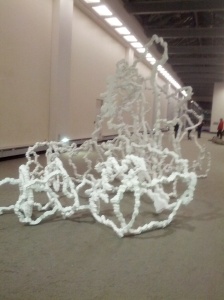This year at the Nuit Blanche in Montreal, I visited the ART SOUTERRAIN. And the theme reminded my of Massesy’s book For space, where she defines space as a social dimension.
space presents us with the social in the widest sense: the challenge of our constitutive interrelatedness – and thus our collective implication in the outcomes of that interrelatedness; the radical contemporaneity of an ongoing multiplicity of others, human and non-human; and the ongoing and ever-specific project of the practices through which that sociability is to be configured. (Massey, 2005, p.192)
A couple of installation were particularly interesting regarding the aspect of space. Here is the explanation of the theme:
LABYRINTH
A labyrinth (in latin, labyrinthus) is a sinuous plan, provided or not of crossings, dead ends and false tracks, intended to slow down or get lost someone who tries to walk through it.
The proposed theme hints at the complexity of Montreal’s underground network, space acting itself as an uncommon space of exhibition during the ART SOUTERRAIN festival. Trade zones, governmental offices, as well as spaces with varied vocations alternate within the RESO – official name of this actual urban maze. These public spaces, administered by private entities, welcome projects of various shapes, which are encountered by the multiple passers-by.
These temporary exhibiting venues shelter artistic installations that echo the innumerable current cultural orientations, exploring the borders of art. The tendencies and movements of contemporary art not being so easily discernible any more, the spectator loses help marks, so the integration of many artworks to the architectures through the course incites him to make the effort to chase them away.
The labyrinth, in contemporary art, transforms itself in a game between the artist and the spectator, where the artwork holds meanning, with reading keys that are not always obvious. Like a nebula, the labyrinth establishes an amalgam between creators, movements and ideas.
Beyond the creative sphere, the labyrintical model is the allegory of the modern self, and more generally, of the societies within which it evolves. It also hints at global culture, at its new and complex communication means and at the various schools of thought. Our time seems to incite us to merge, as much as it corroborates the pecularity of every society. Society has never been as diversified because the identity strata feed themselves of the individuals’ mixing. The virtual transportation means allow us to enjoy these differences without, however, grasping the nuances. http://www.artsouterrain.com/en/theme/
The installation Euromaze is a great example of artist inspire by science and creating a beautiful representation of space. Each piece represent an european country. They held each other and form a unique 3 dimensional map of europe.

ARTIST BIOGRAPHY : llona Staples is a graduate of OCADU and Concordia University, in Montreal. Her work has been exhibited in Canada, the US, England, and Hungary. She has received grants from the Toronto Arts Council and the Ontario Arts Council.
ARTIST STATEMENT : The works of Ilona Staples focus on the theme of “leaky margins” – a term coined by British scientist Peter Russell in his book The Global Brain – to examine the nature of geopolitical boundaries and the forces of globalization, including commerce, immigration, and consumerism. These lead to the shift or dissolution of borders. Inspired by cartography, Staples creates works that illustrate the negative and positive consequences of the porousness and impermanence of boundaries.
www.ilonastaples.com
http://www.artsouterrain.com/en/ilona-staples/

screen capture from my phone
The other installation I like was Note on a public place by Natacha Clitandre in collaboration with Annick Désormeaux. It is fun to see people with their cell phone capture the QR code with their phone. I played along and snap one of the yellow square and got to the web page.
 ARTIST BIOGRAPHY
ARTIST BIOGRAPHY
Natacha Clitandre graduated with a Master’s degree in Theory and Practice of Contemporary Art and New Media. Her work has been exhibited in different European and North-American cities. She lives and works in Montreal.
ARTIST STATEMENT
Hoping to improve daily habits, Natacha Clitandre appropriates different urban contexts and suffuses them with some ubiquitous systems of information distribution. Notes on a public place is an impermanent but monumental display, composed of different notes about the urban environment. Their bright colours match with the unique atmosphere of the Palais des Congrès. The project mixes artistic content, historical facts, and personal anecdotes in an invitation to lose one’s bearings.
http://www.natachaclitandre.net
http://www.artsouterrain.com/en/natacha-clitandre/
❖❖❖
I believe that art and science can inspire each other in a sort of cross-pollination. For me, this night gave me ideas about the concept of space and how to make my writing more creative and visual.
Massey, D. (2005). For space. Thousand Oaks, CA: Sage.



